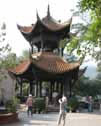
(pic12)Jpeg82k
|
(Xiangfan)
(pic01-03) Liu Bei left Yuan Shao in 201AD, relied on Imperial Protector of Jingzhou, Liu Biao at Xiangyang, and obtained the town Xinye. Liu Bei was chased by Cao Cao 50 thousand army, threw away Xinye and he arrived at Jiangxia through Fancheng at 208AD. Today, Xiangyang and Fancheng adjacent on the other side of Hanshui, amalgamated and it is the second city in Hubei.
Jiangxia(Wuchang) with Xiakou at the opposite bank of the Yangtze were in Wuhan, the Capital of Hubei in present.
(pic04) There is Zhuge Liang plaza in the center of Xiangfan, known as the Sleeping Dragon Ridge, there stands the Kongming statue of 18.4m.
(pic05) Seeing the direction of Hanjiang great bridge from Changhong Bridge on Hanshui. The remains of Xiangyang town site were in the right side shore (south coast). The town was called "Xiangyang of striking iron" from firmness in roadside canals etc.
(Xiangfan-Gulongzhong)
(pic11-19) The hermitage where Zhuge Liang lived before the enter the government service. Zhuge Liang Kongming served as the Prime Minister to Liu Bei Xuande who became a king of Shu, afterward.
Liu Bei was visited Kongming at Gulongzhong three times, and invited him as a strategist in 207AD. Kongming explained "divide the country into three" plan to Liu Bei then.
(Dangyang-Changban)
(pic21-31) When Liu Bei fought against Cao Cao of Wei and defeated in year of AD208, the vassal, Zhao Yun Zilong at that time went into the enemy's camp all alone, and helped eldest son of Liu Bei (who became the second Shu's emperor Liu Shan, afterward). The bronze statue has been built in the center of the Dangyang city. It has become a park and the clay figure stands the battlefield site moreover.
(pic32) Zhang Fei, waiting for Zhao Yun who did not return, drew himself up to his full height and defended against the Cao Cao army on the bridge of the branch of Hanshui then. The mark is at the intersection in the field now, and neither water nor the bridge remain. However, one stone monument has been built.
|

(pic13)Jpeg82k
|

(pic14)Jpeg71k
|

(pic42)Jpeg78k
|

(pic43)Jpeg61k
|

(pic44)Jpeg64k
|
(Red Cliff Hills)
(pic41-48) General Zhou Yu of Wu fire attacked and broke the boasted mass fleet of Wei in year of 208AD. They say that he engraved the character of "Red cliffs" there with the sword in the banquet of the victory.
The width of a river broadens suddenly when Yangtze River descends around here. The ferry is indispensable for the coming and going of both shores.
(pic41-43) are the north shore Wulin Guzhanchang where the Cao Cao army set up the formation.
(pic49) Kongming went to Wu to defeat Wei. He shut himself up in Baifengtai for three full days, and prayed for the southeast wind at the end of fall for making the plan of the fire attack of Zhou Yu succeed. Was it an Indian summer?
(pic50) Here is the great war exhibition pavilion where the articles excavated from the coast of Yangtze River stored. The clay figures and arms connected to the anecdote in three country age are exhibited.
The poet, Su Dongpo believed Red Nose(Chibi, Same pronunciation in Chinese) downstream in Wuhan to be Red Cliffs, and composed poetry, so that people called that red cliffs of the scholarship and called here of three kingdoms the red cliffs of the martial.
|

(pic71)Jpeg77k
|

(pic72)Jpeg78k
|
(Ancient city of Jingzhou)
(pic61-69) Sun Quan of Wu lended Jingzhou to Liu Bei at 210AD. Afterwards, Guan Yu defended there. They say Guan Yu fortificated on the ancient fort of Chu. The existent city walls are repaired in the Qing dynasty.
Jingzhou also called Jiangling but Jiangling and Shashi amalgamated and once became Jiangsha. The present name is returned to Jingzhou.
(Dangyang-Guanling)
(pic71-73) It is said that there are three graves of Guan Yu killed by Wu 219AD. Here at Dangyang buried his body, at Luoyang buried his head, and at Zhang Fei mausoleum of Yunyang (Because it sank in Three Gorges Dam, the move was done) buried his clothes.
(pic74) A donkey was protecting the grave in front of Guanling under the hot weather of 30degree C.
(Luoyang-Guanlin Temple)
(pic75-79) Sun Quan of Wu carved the head of Guan Yu, feared the revenge of Liu Bei and sent it to Wei. Cao Cao that penetrated the intention was cordially buried it to Luoyang. The place is Guanlin Temple.
(Baidicheng)
(pic80-89) Liu Bei Xuande, the emperor of Shu Han was dead in 223AD. The Baidicheng, white emperor castle became the last castle for him. The clay figures are Xuande leaves the will for the elder statesmen when happening in the hour of death.
(Chengdu-Wuhou Memorial Temple)
(pic90-95) The grave of Liu Bei Xuande, King of Shu. Zhuge Kongming was enshrined in Zhaolie mausoleum afterward. However, the latter name came to be excelling some day and it became called Wuhouci. The Huiling is believed to be the grave of Liu Bei 60% or more though has not been opened yet.
(Sep. 2002)
(pic75-79) (Sep. 1998)
(pic90-95) (Sep. 2001)
|

(pic73)Jpeg99k
|






































































 to the Top
to the Top to China
to China to HomePage
to HomePage